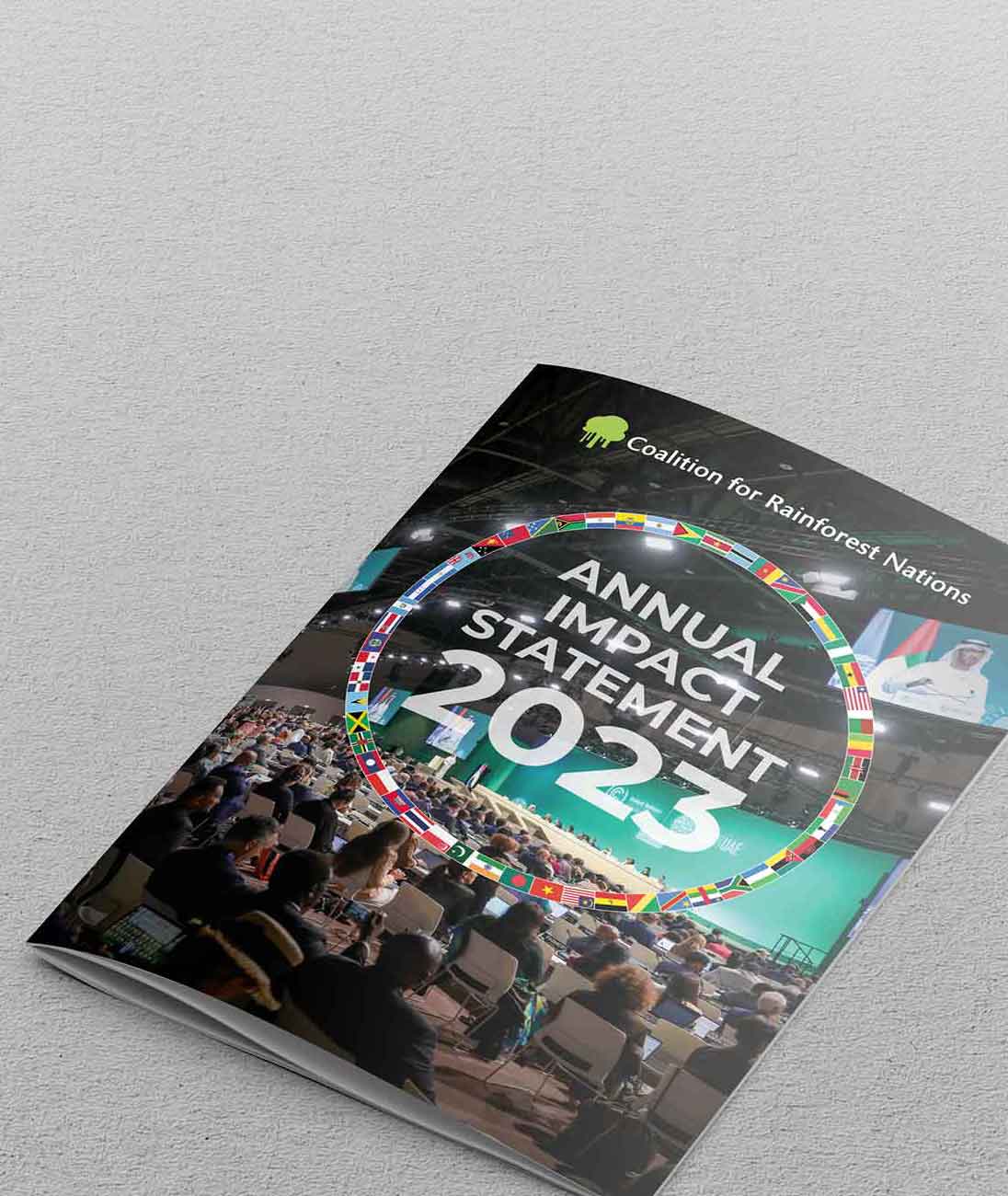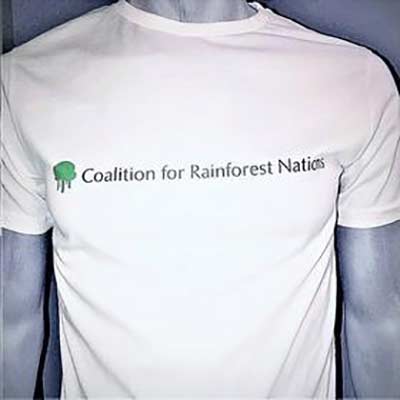CfRN Frequently Asked Questions
CfRN Frequently Asked Questions
Kevin Conrad of Papua New Guinea and Federica Bietta of Italy – two bold MBA graduate students at Columbia University– took on a challenge to change the world for the better. Inspired by a call to action by the late Grand Chief Sir Michael Somare, Prime Minister of Papua New Guinea, Kevin and Federica posed themselves the question of how to conserve the planet’s rainforests and bring equity to people around the world.
Their thesis: make trees worth more alive than dead. After all, rainforests provide a natural service for free; they absorb carbon dioxide, the greenhouse gas primarily responsible for climate change, and stop its release into the atmosphere. Dr. Geoffrey Heal, an economics professor at Columbia University, had written about nature and its role in the marketplace. What if the world attributed a financial value to that natural service? The largest contributors to greenhouse gas emissions could then pay for this service provided by the rainforests in countries hardest hit by the effects of climate change, slowing the acceleration of climate change and global inequity. Kevin and Federica dubbed their effort Reducing Emissions from Deforestation (RED).
As with many paradigm-shifting ideas, people were initially skeptical. But Nobel Prize-winning economist Joseph Stiglitz, an advisor, wasn’t! Neither were the governments of Costa Rica and Papua New Guinea. That December, after securing the formal support of Papua New Guinea and the Costa Rican government, the newfound Coalition travelled to the United Nations Climate Summit in Montreal, Canada, for the opportunity to be heard on a global stage. At the Montreal Climate Summit (2005), the Coalition introduced and championed a proposal for a results-based RED mechanism for consideration by the world. This was based on the idea of positive incentives for developing countries to retain their rainforests and seek payments for results of retaining their national rainforest reference levels’ to ‘for results measured against their national rainforest reference levels. This framework was tabled by the Coalition for Rainforest Nations, Papua New Guinea, and Costa Rica.
CfRN is an official party group at the UNFCCC, supported by a small, cost-effective, diverse, and highly skilled Secretariat from over 15 different countries across the USA, Europe, South-East Asia, Central & South America, and Africa. Our headquarters are in New York, USA
To help rainforest nations slow, stop, and reverse deforestation
CfRN provides support to developing countries to help save tropical rainforests at national level, preserving the planet’s biodiversity and beauty while also providing a powerful absorber of CO2.
Specifically, CfRN works on three areas of support:
- Policy: We empower developing countries to negotiate what’s in the best interests for their forests and communities within the UNFCCC and other climate policy fora, and support developing countries’ efforts to devise domestic climate policy,
- Knowledge: We provide technical training and capacity-building to our countries forestry and climate agencies to help them measure efforts to slow deforestation and report back to the United Nations.
- Finance: We help countries attract climate finance to developing countries for slowing deforestation at national level
For over a decade, CfRN worked tirelessly with developing countries to guarantee the inclusion of rainforests within the global climate agreement, called the Paris Agreement (2015-today). Under the previous climate agreement, the Kyoto Protocol (2005-2015), rainforests were not recognized as a climate solution, and as a result rainforest nations did not have “a seat at the table” in global climate negotiations. So, CfRN focused on helping developing countries negotiate a framework for slowing deforestation into the Paris Agreement. In 2015, CfRN and its countries succeeded.
The Reducing Emissions from Deforestation and Degradation (REDD+) framework was recognized by over 190 countries and enshrined in Article 5.2 of the Paris Agreement. In principle, the framework allows developing countries to receive performance-based or reward-based payments, through Article 5.2, for national efforts to slow, stop, and reverse deforestation. Since 2005, our countries have reduced 13 billion tons of CO2 emissions, but only 4% of these reductions have received climate finance.
Today, CfRN continues to support developing countries in their efforts to strengthen the REDD+ framework within the overall UNFCCC including the Paris Agreement and finally receive climate finance for efforts to slow deforestation and reduce emissions. The Paris Agreement is complex, including decisions by 190 nations over two decades, and continues to evolve. CfRN provides consistent guidance to our countries whose governments change over time. We offer them the institutional knowledge on climate treaties to help them make the best decisions for their forests and communities. In addition, CfRN helps developing countries devise national climate policy to comply with the Paris Agreement.
A challenge for many of our countries is how to show the international community that they are slowing deforestation. All countries need to create systems and accumulate measurement data on land management and forests, and many countries have gaps in accurate reporting on emissions from agriculture, forests, and other land use. These gaps must be resolved before they can report their results to the United Nations. CfRN provides ongoing capacity-building and training to help countries create emissions inventories and report on forest- and land-based emissions as well as their rainforest conservation efforts.
We help our countries set up the infrastructure, build partnerships, and attract investment so that they can receive climate financing for proven efforts to slow, stop and reverse deforestation and reduce emissions.
While we were successful in our mission to mandate REDD+ as part of the Paris Agreement, countries are still negotiating the implementation rules of the Paris Agreement.
At CfRN, we pride ourselves on offering the best philanthropic return on your dollar. From our inception, we have remained small and nimble, yet our impact has been very cost-effective, significant, and far-reaching. CfRN was hailed by the New York Times in 2020 as one of the two most effective organizations in the world on climate change? The accolade remains true today.
Tropical rainforests and land are a critical climate solution that our countries offer to the world, and without which our climate goals will not be possible. Combining an energy transition with our planet’s natural solutions gives us the best shot at aligning to the elusive 1.5 degrees C pathway in time. Rainforests are one of the largest and most cost-effective emission reduction opportunities for the planet.
Reducing Emissions from Deforestation and Degradation (REDD+) is the only global conservation system to preserve and protect rainforests by making them worth more alive than dead – and is critical. The UNFCCC REDD+ framework enables rainforest nations to obtain economic value for carbon reductions resulting from actions they take to reduce deforestation and preserve their rainforests.
It was developed by our countries under the United Nations Framework Convention on Climate Change (UNFCCC) to create financial value for the carbon stored in forests. It is the only emissions reduction program and standard included in the Paris Agreement and approved by over 190 countries. The term REDD+ is enshrined in Article 5.2 of the Paris Agreement.
UNFCCC REDD+ framework evolved over 20 years through decisions from over 190 countries.
80 countries are actively involved in UNFCCC REDD+ framework either as rainforest nations or donors.
REDD+ is contentious for two reasons:
- Some people and organizations do not believe that a market-based mechanism should be used to conserve rainforests. These organizations include Greenpeace and REDD+ Monitor. However, these organizations do not put forward alternative solutions. With the urgency of the climate crisis, we believe that a well-designed, performance-based, market-based approach with high environmental integrity and safeguards is the best solution we have.
- The purpose of REDD+ was to support national efforts to slow, stop, and reverse tropical deforestation under UNFCCC. While the term REDD+ is enshrined in Article 5.2 of the Paris Agreement, it was never patented by UNFCCC. That means that any forestry carbon project can use the name REDD+ without any methodological or legal connection to the Paris Agreement and UNFCCC. Since the 2000’s, the voluntary carbon markets, which operate outside the Paris Agreement, have monopolized the use of the term REDD+ and tarnished its reputation with a significant number of scandals.
- UNFCCC REDD+ framework works and has been operating since 2005. During that time, countries has reduced over 13 gigatons of emissions and helped slow deforestation at national level
- Voluntary carbon projects, which cover small areas of a rainforest, are mostly hot air. They often operate without oversight and approval from host governments or with governments who are not active within UNFCCC REDD+. In 2023, the voluntary carbon markets were exposed internationally for lack of environmental integrity and financial irregularities. Multiple studies and media articles have covered the sector, including The Guardian, Science Journal, Bloomberg. Unfortunately, this has given the term REDD+ a negative connotation, despite these scandals being in no way connected to UNFCCC REDD+ framework
The UNFCCC is responsible for reviewing, auditing, and verifying a country’s performance to reduce emissions under UNFCCC REDD+. All government action and reporting are fully transparent on UNFCCC REDD+ hub. Based on successful conservation efforts, the UNFCCC verifies the emission reductions accomplishes which are called REDD+ results. Further information about UNFCCC REDD+ can be found on UNFCCC REDD+ hub










